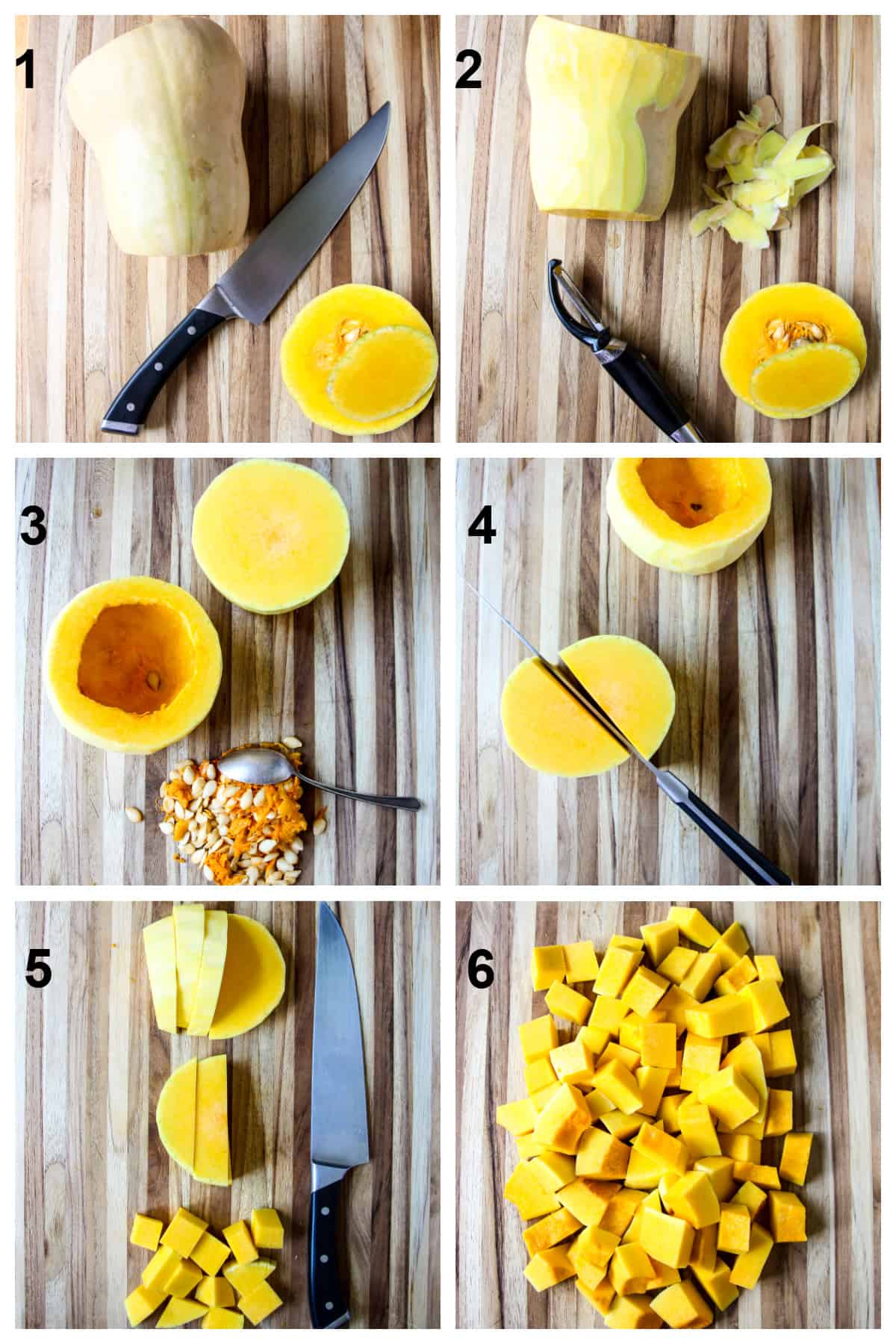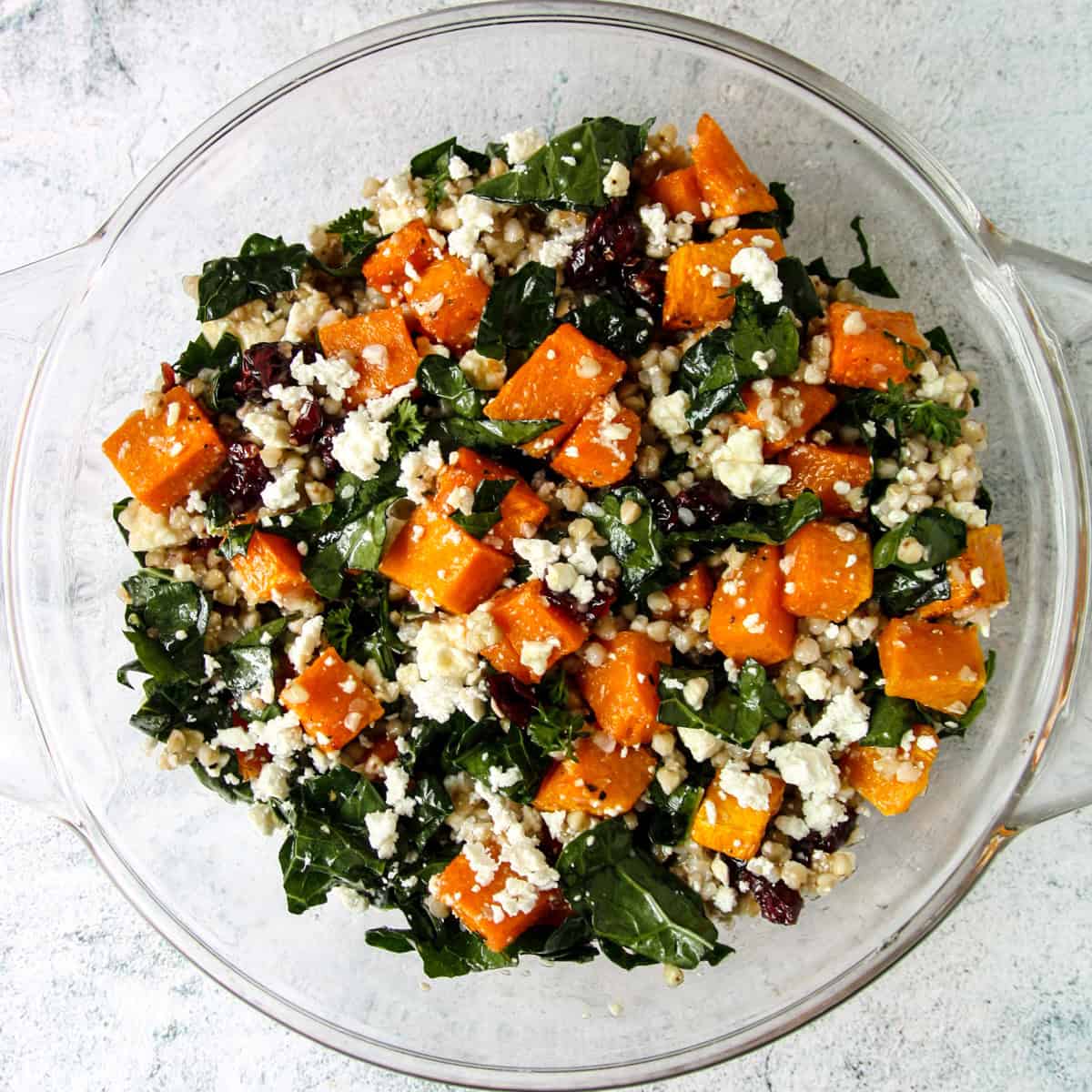Butternut Squash Salad with Feta and Buckwheat is a delicious, nutrient-packed dish that combines sweet roasted butternut squash, creamy, salty feta cheese, and the hearty texture of buckwheat. It’s all tossed in a tasty and easy dressing made with maple syrup and Dijon mustard. This vibrant, healthy salad is perfect as a meal or as a side dish.

Want to save this recipe?
Enter your email & I’ll send it to your inbox. Plus, get great new recipes from me every week!
Did I ever mention how much I love buckwheat? Actually, I think I did, here, in this Mediterranean Buckwheat Salad, which is equally delicious. As I mentioned in that post, Buckwheat is not wheat, in spite of its name. It is actually a seed, (called groats), and a member of the rhubarb family.

Jump to:
What we love about this salad
- Healthy: Butternut squash is high in fiber and loaded with vitamins and minerals like vitamin A, vitamin C, potassium, calcium and iron. Buckwheat is also a nutritional superstar, with plenty of fiber, amino acids and minerals. We all know that kale is super good for us, and feta cheese is calcium and protein-rich.
- Easy: The hardest part of making this butternut squash salad recipe is peeling and cubing the squash. After it’s roasted and cooled, you just have to toss everything together.
- Economical: Butternut squash, buckwheat, and kale are budget friendly grocery items.
- Meal prep friendly: This delicious salad keeps well, and makes a large batch, making it perfect for meal prep.
Ingredient notes
For the salad
- Butternut squash: Look for a squash that’s heavy for its size. The color should be uniform, tan or light orange and will be matte as opposed to shiny. You can also save time by buying pre-cut and packaged butternut squash. See further down in this post for how to cut a butternut squash.
- Buckwheat groats: You can find buckwheat groats in the grains and cereal isle at the grocery store. If not there, try the rice and beans section. Buckwheat groats take just 10 minutes to cook.
- Kale: You can use any type of kale. Curly kale and Lacinato kale are most commonly found in grocery stores.
- Feta cheese: You can use the type of feta packed in brine in a block, or use the dry crumbled feta.
- Dried cranberries, olive oil, salt and pepper.

For the dressing
- Olive Oil: I always use extra virgin olive oil for salads, but avocado oil is also a good choice.
- Maple Syrup: Use real maple syrup for this roasted butternut squash salad.
- Dijon mustard: You can also use whole grain, or grainy mustard.
- White wine vinegar: Feel free to use apple cider vinegar instead.

How to cube a butternut squash
- First, using a sharp knife, and a sturdy cutting board, cut off the top and bottom from the squash.
- Peel the squash, using a sharp vegetable peeler.
- Cut the squash in half where the neck meets the bulb, and with a spoon, scoop out the seeds and stringy parts from the bulb section.
- Standing the halves upright on the cutting board, cut each one in half.
- Lay the halves cut side down and slice them into half circles. Cut each half circle into sticks.
- Finally, cut the sticks into one inch cubes.

How to make butternut squash salad, step by step
Ingredient quantities and full instructions are in the printable recipe card at the bottom of this post.
- Cook the buckwheat groats according to package directions. Usually this takes 10 minutes. A half cup of groats will yield one cup of cooked buckwheat. Allow to cool. In a medium bowl, toss the cubed butternut squash with olive oil, salt, and pepper.
- Spread the squash pieces in a single layer in the basket of an air fryer. Air fry 15 minutes. Or spread them on a parchment paper lined baking sheet and roast in the oven for 30 minutes. With either method, the butternut cubes should be fork tender with slightly caramelized edges.

- Remove kale leaves from the ribs and stems, and chop into bite sized pieces. Add the chopped kale leaves to a medium bowl with 2 teaspoons of olive oil. Use your hands to massage the leaves for 2-3 minutes until they have softened and turned dark green.

- In a large salad bowl, whisk together the maple Dijon dressing ingredients.
- Add the cooled butternut squash, cooked buckwheat, kale, cranberries, and feta cheese. Toss gently to combine.

Variations
- Squash: In place of butternut, you can use acorn squash or any other winter squash for this delicious salad.
- Grain: Buckwheat, in spite of it’s name, is not wheat and is gluten-free. You can also use quinoa, which works great in hearty salads (try my quinoa chickpea salad with sweet potatoes). If gluten isn’t a concern, barley or faro are other grain choices that will work in this hearty salad.
- Greens: Instead of kale, you can use baby spinach, arugula (rocket), swiss chard, or a blend of hearty greens.
- Cranberries: Substitute the dried cranberries with pomegranate seeds (pomegranate arils). Both are festive enough to make this a perfect salad for Thanksgiving dinner or side dish or any holiday meal.
- Cheese: Use gorgonzola, blue cheese, goat’s cheese or parmesan if you prefer it to feta. To make this butternut squash salad vegan, use vegan feta or omit the cheese.
- Crunch: Add some crunch with toasted walnuts, pecans, sunflower seeds, or pumpkin seeds. I even like to add some of my roasted chickpeas sometimes.
- Aromatics: Add sliced red onion or green onions (scallions). Or you can add a couple of gloves of garlic, minced, to the salad dressing ingredients.
Pro Tips
- Cutting butternut squash: Try to cut the squash in uniform sized pieces, so that they will cook evenly. Use a sharp knife and a sturdy cutting board.
- Roasting the squash: Ever since I first made Air fryer butternut squash, it has been my favorite way to roast it. However, you can just as easily roast your squash in the oven, it simply takes a little longer. As with all roasted vegetables, spread the pieces in an even layer with space around them. This ensures they will be crisp and golden.
- Massage the kale: Be sure not to skip this step. Massaging releases some of the kale’s bitterness, and it breaks down the cell walls, making it more tender and easier to eat. If you are using any other, more tender greens (suggested above), there is no need for massaging.
- Serving temperature: I prefer to serve this roasted butternut feta salad after chilling it in the fridge for a couple of hours. However you can serve it as a warm butternut squash salad before the squash has cooled, and it’s delicious. It’s equally good at room temperature, too.
- Storage: Store leftover butternut squash salad in an airtight container in the fridge for up to three days.
- Make ahead: For best results, assemble the salad just before serving. However, you can cook the buckwheat and roast the butternut squash ahead of time and store them in the fridge until then.

Did you make this recipe? Please leave a rating in the comments below and let us know how it turned out. Did you make any changes? We would love for you to share and your feedback is important! Thank you for visiting The Food Blog!
Recipe
Want to save this recipe?
Enter your email & I’ll send it to your inbox. Plus, get great new recipes from me every week!

Butternut Squash Salad with Feta and Buckwheat
Butternut Squash Salad with Feta and Buckwheat is a delicious, nutrient-packed dish that combines sweet roasted butternut squash, creamy, salty feta cheese, and the hearty texture of buckwheat. This vibrant, easy to make salad is perfect as a meal or as a side dish.
Print Pin Rate Save RecipePrevent your screen from going dark
Servings: 6 servings
Calories: 222kcal
Instructions
Cook the buckwheat groats according to package directions. Usually this takes 10 minutes. A half cup of groats will yield one cup of cooked buckwheat. Allow to cool.
In a medium bowl, toss the cubed butternut squash with one tablespoon of olive oil, salt, and pepper.
Spread the squash pieces in a single layer in the basket of an air fryer. Air fry 15 minutes. Or spread them on a parchment paper lined baking sheet and roast in the oven for 30 minutes. With either method, the butternut cubes should be fork tender with slightly caramelized edges.
Remove kale leaves from the ribs and stems, and chop into bite sized pieces. Add the chopped kale leaves to a medium bowl with 2 teaspoons of olive oil. Use your hands to massage the leaves for 2-3 minutes until they have softened and turned dark green.
In a large salad bowl, whisk together the dressing ingredients; maple syrup, olive oil, white wine vinegar and Dijon mustard.
Add the cooled butternut squash, cooked buckwheat, kale, cranberries, and feta cheese. Toss gently to combine.
Notes
- Cutting butternut squash: Try to cut the squash in uniform sized pieces, so that they will cook evenly. Use a sharp knife and a sturdy cutting board.
- Roasting the squash: Ever since I first made Air fryer butternut squash, it has been my favorite way to roast it. However, you can just as easily roast your squash in the oven, it simply takes a little longer. As with all roasted vegetables, spread the pieces in an even layer with space around them. This ensures they will be crisp and golden.
- Massage the kale: Be sure not to skip this step. Massaging releases some of the kale’s bitterness, and it breaks down the cell walls, making it more tender and easier to eat. If you are using any other, more tender greens (suggested above), there is no need for massaging.
- Serving temperature: I prefer to serve this roasted butternut feta salad after chilling it in the fridge for a couple of hours. However you can serve it as a warm butternut squash salad before the squash has cooled, and it’s delicious. It’s equally good at room temperature, too.
- Storage: Store leftover butternut squash salad in an airtight container in the fridge for up to three days.
- Make ahead: For best results, assemble the salad just before serving. However, you can cook the buckwheat and roast the butternut squash ahead of time and store them in the fridge until then.
Nutrition
Serving: 1g | Calories: 222kcal | Carbohydrates: 36g | Protein: 5g | Fat: 8g | Saturated Fat: 2g | Polyunsaturated Fat: 1g | Monounsaturated Fat: 4g | Cholesterol: 11mg | Sodium: 257mg | Potassium: 542mg | Fiber: 5g | Sugar: 12g | Vitamin A: 13.691IU | Vitamin C: 30mg | Calcium: 139mg | Iron: 1mg


